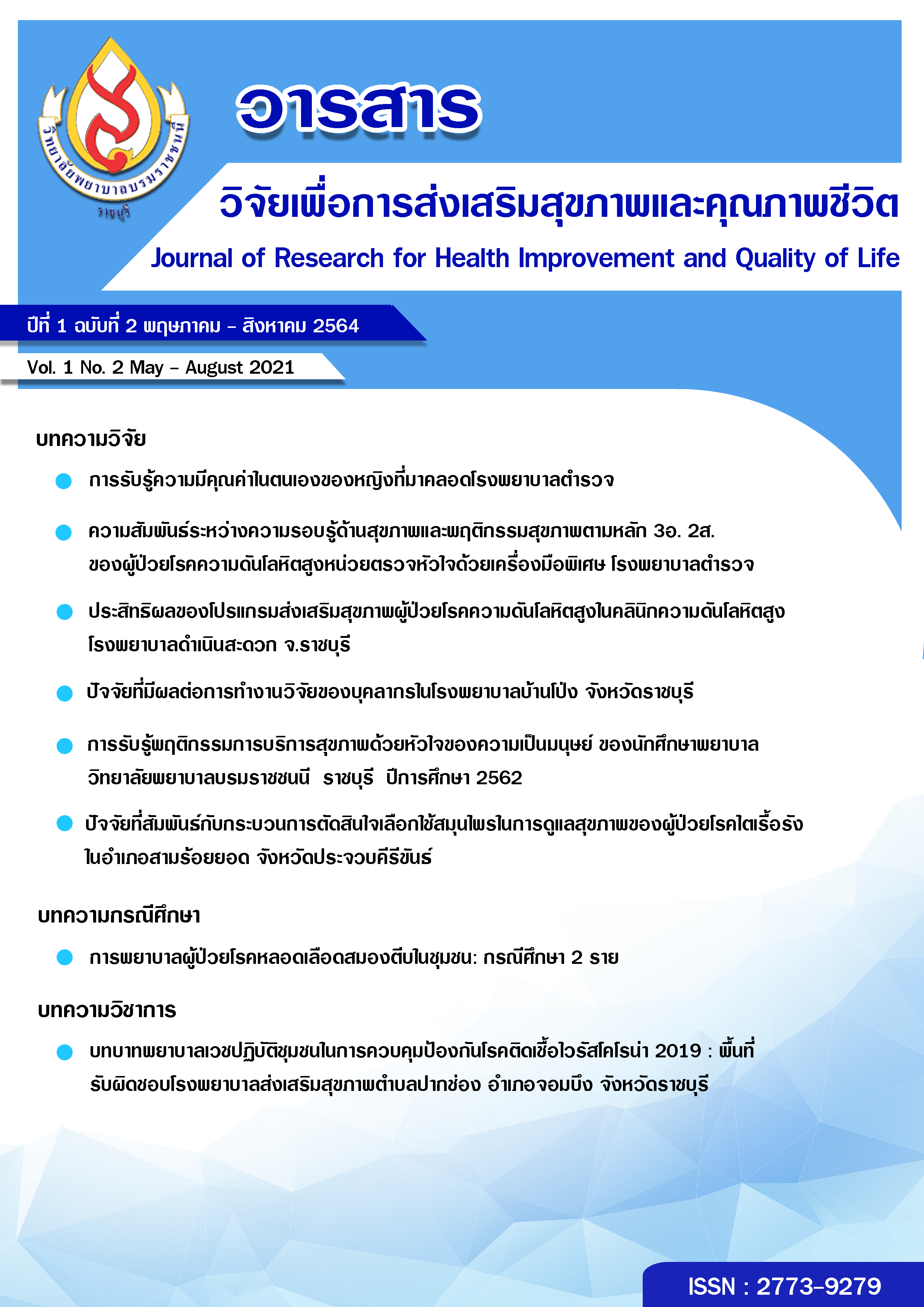ปัจจัยที่สัมพันธ์กับกระบวนการตัดสินใจเลือกใช้สมุนไพรในการดูแลสุขภาพของผู้ป่วยโรคไตเรื้อรังในอำเภอสามร้อยยอด จังหวัดประจวบคีรีขันธ์
คำสำคัญ:
กระบวนการตัดสินใจ, สมุนไพร, ผู้ป่วยโรคไตเรื้อรังบทคัดย่อ
การวิจัยเชิงสหสัมพันธ์มีวัตถุประสงค์เพื่อศึกษา 1) ระดับการสื่อสารทางสุขภาพ แรงจูงใจในการป้องกันโรค และกระบวนการตัดสินใจเลือกใช้สมุนไพรในการดูแลสุขภาพของผู้ป่วยโรคไตเรื้อรัง และ 2) เพื่อศึกษาปัจจัยที่มีความสัมพันธ์กับกระบวนการตัดสินใจเลือกใช้สมุนไพรในการดูแลสุขภาพของผู้ป่วยโรคไตเรื้อรังในอำเภอสามร้อยยอด กลุ่มตัวอย่างเป็นผู้ป่วยโรคไตเรื้อรัง 152 คน เครื่องมือเป็นแบบสอบถามการสื่อสารทางสุขภาพ แรงจูงใจในการป้องกันโรคและกระบวนการตัดสินใจเลือกใช้สมุนไพรดูแลสุขภาพ วิเคราะห์ข้อมูลโดยสถิติพรรณนาและสัมประสิทธิ์สหสัมพันธ์ของเพียร์สัน ผลการวิจัย พบว่า
1. คะแนนเฉลี่ยการสื่อสารทางสุขภาพ อยู่ในระดับสูง (M= 4.05, SD=0.39) แรงจูงใจในการป้องกันโรค และกระบวนการตัดสินใจเลือกใช้สมุนไพรดูแลสุขภาพ อยู่ในระดับปานกลาง (M= 3.41, SD=0.62; M=3.48, SD=0.59) ตามลำดับ
2. การสื่อสารทางสุขภาพมีความสัมพันธ์ทางบวกระดับสูงกับกระบวนการตัดสินใจเลือกใช้สมุนไพรดูแลสุขภาพของผู้ป่วยโรคไตเรื้อรัง (r =.702, p<.05) ส่วนแรงจูงใจในการป้องกันโรคมีความสัมพันธ์ทางบวกระดับปานกลางกับกระบวนการตัดสินใจเลือกใช้สมุนไพรดูแลสุขภาพ (r =.591, p<.01)
ดังนั้นพยาบาลที่ดูแลผู้ป่วยโรคไตเรื้อรังควรใช้กระบวนการสื่อสารทางสุขภาพที่ผู้ป่วยและญาติสามารถเข้าถึงได้ และมีเนื้อหาที่เข้าใจง่ายเพื่อเสริมสร้างความรู้ความเข้าใจนำไปสู่กระบวนการตัดสินใจเลือกใช้สมุนไพรดูแลสุขภาพตามคำแนะนำของบุคลากรทางการแพทย์ได้อย่างเหมาะสม
เอกสารอ้างอิง
Bureau of Policy and Strategy, Ministry of Public Health .(2017). Public health statistics A.D. 2016. Nonthaburi. (in Thai)
Chuntum, K., Kamlangluea, K. (2017). Treatment with herbs and the ancient recipe of traditional medicine. J Med Health Sci, 24(2), 48-57. (in Thai)
Darun, P., & Kairat, P. (2019). Health literacy factors influencing on health behavior of population in Bueng Kan Province. Journal of Department of Health Service Support, 15(3), 71-82. (in Thai)
Department of Disease Control. (2019). The report of the situation of NCD (DM HT and risk factors in 2019). Nonthaburi: Aksorn Graphic and Design Publishing Limited Partnership. (in Thai)
Faul, F., Erdfelder, E., Buchner, A., & Lang, A. G. (2009). Statistical power analyses using G*Power 3.1: Tests for correlation and regression analyses. Behavior Research Methods, 41(4), 1149-1160.
Health Data Center, Ministry of Public Health .(2019). The report of number of chronic kidney disease patients receiving services at the hospital, classified by stage. Retrieved June 15, 2021 from https://www.pkn.hdc.moph.go.th/hdc/reports/report.php?source=pformated/format1.php&cat_id=e71a73a77b1474e63b71bccf727009ce&id=e69c7fae93eda2222aa210d5db512290
Hinkle, D. E. (1998). Applied statistics for the behavior sciences (4th ed.). New York: Houghton Mifflin.
Kotler, P., & Keller, K. L. (2006). Marketing management (12th ed.). New Jersey: Pearson Prentice Hall.
Mattavangkul, C., Kawitu, K., Deenoo, S., & Sinwannakoo, S. (2019). Factor related to herbal use behavior for self-care among people in Phasi-Chareon District. Journal of Nursing Siam University, 20(39), 99-109. (in Thai)
Nonthapha, S., Navicharern, R. (2017). Factors related to protection motivation theory and breast cancer prevention behavior among teachers in provincial school, central region. Kuakarun Journal of Nursing, 24(2), 23-35. (in Thai)
Ratzan, S. C., Payne, J. G., & Bishop, C. (1996). The status and scope of heath communication. Journal of Health Communication, 1(1), 25 -41.
Sisaaad, B. (2013). Introduction to research (9th ed.). Bangkok: Suwiriyasan Publisher. (in Thai).
Steven, P.D., & Rogers, R. W. (1986). Protection motivation theory and preventive health: beyond the health belief model. Health Education Research, 1(30), 153-161.
ดาวน์โหลด
เผยแพร่แล้ว
ฉบับ
ประเภทบทความ
สัญญาอนุญาต
ลิขสิทธิ์ (c) 2021 วิทยาลัยพยาบาลบรมราชชนนี ราชบุรี

อนุญาตภายใต้เงื่อนไข Creative Commons Attribution-NonCommercial-NoDerivatives 4.0 International License.
บทความทีตีพิมพ์ในวารสารนี้ถือว่าเป็นลิขสิทธิ์ของวิทยาลัยพยาบาลบรมราชชนนี ราชบุรี และผลงานวิชาการหรือวิจัยของคณะผู้เขียน ไม่ใช่ความคิดเห็นของบรรณาธิการหรือผู้จัดทํา




